It’s a simple, straight forward question…what’s better for you – roasted or raw nuts?
 I think most of us have heard that grabbing a handful of nuts, like almonds, satiates the appetite. In other words, those little nuggets get you by until your next meal because they’re packed with omega – 3 fatty acids, protein, and fiber; all great things to make a healthy body. But is there a difference between roasted and raw nuts when it comes to getting the most from a nut?
I think most of us have heard that grabbing a handful of nuts, like almonds, satiates the appetite. In other words, those little nuggets get you by until your next meal because they’re packed with omega – 3 fatty acids, protein, and fiber; all great things to make a healthy body. But is there a difference between roasted and raw nuts when it comes to getting the most from a nut?
Let’s not put the answer off. Simply put, raw nuts are slightly better for you than roasted nuts because roasted nuts are ‘roasted’ with oil which ups the fat content, and secondly, heating nuts to high temperatures brings up the question of whether high heat destroys any of the nutrients nuts so graciously provide us with.

I found conflicting opinions concerning roasting nuts and seeds within two livestrong.com articles:
- “Roasting nuts and seeds does not significantly change their nutritional value, and claims that roasting nuts changes fat composition or reduces vitamin E are untrue,” according to Karen Collins, M.S., R.D., C.D.N., of the American Institute for Cancer Research. (1)
- Chemical analysis of a variety of raw and processed nuts, published in the “Journal of Agricultural and Food Chemistry” in 2008, reveal “heat treated nuts compared to the raw ones, show an increase of trans fats, a type of fat that the American Heart Association recommends to be eliminated from your diet due to its adverse health effects.”(2) It also shows an increase in lipid oxidation which is a major cause of food quality deterioration.
According to prevention.com, raw and roasted varieties have basically the same protein, fiber, carbs, and potassium levels, but raw nuts edge out roasted in iron, magnesium, and phosphorus levels, and have less fat. Check out their website below for more information.
“Technically raw nuts rule. They’re an amazing source of vitamins, nutrients, healthy fats, and straight-up fuel.”(3)
We could stop right there, but there’s more to the story. If you’re confused by labeling terms like “organic” and “100 percent natural” when looking at store shelves full of nuts, you need to read on. If you are unaware that almonds are pasteurized, if you are unfamiliar with the chemical terms propylene oxide (PPO) and acrylamide, you need to read on, because you won’t find these terms on any ingredient list.
Brace yourselves; the waters just got rougher and murkier in the nut world!
The skinny on ‘organic’ vs ‘100 percent natural’.
 I have to be honest; until I started to research for this blog I’m not sure I noticed that nut bags were labeled ‘organic’ or ‘100 percent natural’, but I do now. The difference is pretty basic.
I have to be honest; until I started to research for this blog I’m not sure I noticed that nut bags were labeled ‘organic’ or ‘100 percent natural’, but I do now. The difference is pretty basic.
“Organic labels have legal implications. A manufacturer must follow the specified rules and regulations before using the organic label. Natural labels are normally used freely by manufacturers due to lack of adequate guidelines.”(4)
“Unlike organic, which is the only such label with the statutory weight of law, the term “natural” mostly is meaningless marketing. No government agency, certification group, or other independent authority defines the term “natural” on packaging or ensures the claim is truthful.”(5)
 “Only the organic label guarantees a food was produced without harmful pesticides, genetically engineered organisms, toxic solvents, carcinogenic fumigants, sewage sludge, irradiation, non-therapeutic antibiotics and artificial hormones. Unless explicitly stated otherwise, “natural” claims do not provide any such assurance.”(5)
“Only the organic label guarantees a food was produced without harmful pesticides, genetically engineered organisms, toxic solvents, carcinogenic fumigants, sewage sludge, irradiation, non-therapeutic antibiotics and artificial hormones. Unless explicitly stated otherwise, “natural” claims do not provide any such assurance.”(5)
Although I’m not usually enthusiastic about government policy when it comes to our food, it appears that choosing food that shows the USDA certified organic seal is a better choice than choosing products that claim to be ‘100 percent natural’. That being said, just like with wine, the USDA seal is only placed on foods that claim to be ‘100 percent organic’ and ‘organic’; ‘made with’ organic and ‘specific organic ingredients’ will not be awarded the seal.
Also, I found that organic farmers can find loopholes and petition for the right to use certain substances as outlined by the USDA in the National List of Allowed and Prohibited Substances; surprise, surprise! (https://www.ams.usda.gov/rules-regulations/organic/national-list).
 According to Jean Sumner, author of “52 Tips to be Healthy” and co-founder of World Wellness Education, organic is undoubtedly the way to go! If not held to the regulations the USDA organic seal requires, nuts and seeds, such as almonds and sunflower seeds are higher in oils like almonds and can more readily absorb pesticides. Also, peanuts which are actually a legume but welcomed with open arms into the nut world, are prone to mold unless grown in areas like the South West where humidity is not a problem. Check out Jean’s website to get a better understanding of the dangerous chemicals nuts can come into contact with and why she is adamant about organic nuts. http://www.worldwellnesseducation.org/nuts-and-seeds/
According to Jean Sumner, author of “52 Tips to be Healthy” and co-founder of World Wellness Education, organic is undoubtedly the way to go! If not held to the regulations the USDA organic seal requires, nuts and seeds, such as almonds and sunflower seeds are higher in oils like almonds and can more readily absorb pesticides. Also, peanuts which are actually a legume but welcomed with open arms into the nut world, are prone to mold unless grown in areas like the South West where humidity is not a problem. Check out Jean’s website to get a better understanding of the dangerous chemicals nuts can come into contact with and why she is adamant about organic nuts. http://www.worldwellnesseducation.org/nuts-and-seeds/
What’s the deal with pasteurization?
Pasteurization not only pertains to milk; even nuts are subject to high heat in order to kill harmful bacteria. In 2007, a salmonella outbreak in California was the breaking point for the USDA to enforce a pasteurization regulation for almonds.
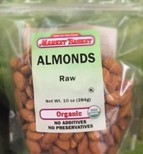 “As of September 1, 2007 the Almond Board of California (ABC) and the United States Department of Agriculture (USDA) made it mandatory for all raw almonds sold to consumers in North America to be pasteurized. The Food and Drug Administration (FDA) is the agency responsible for approving treatment processes.”(6)
“As of September 1, 2007 the Almond Board of California (ABC) and the United States Department of Agriculture (USDA) made it mandatory for all raw almonds sold to consumers in North America to be pasteurized. The Food and Drug Administration (FDA) is the agency responsible for approving treatment processes.”(6)
Why is almond pasteurization so controversial?
It’s how the almonds are pasteurized that has sparked controversy. Currently, there are four methods for killing bacteria in nuts: blanching, roasting, steam treatment, and propylene oxide treatment (PPO); but steam and PPO are most commonly used.
Steam pasteurization, according to justalmonds.com, is when “short bursts of steam are shot onto the outer skin on the almond and do not affect the nutritional integrity of the almond.”(6) All of those great vitamins and minerals are kept intact. Sounds safe enough.
On the other hand, propylene oxide (PPO) is a chemical applied to the outside of the nut, that supposedly dissipates after treatment. So, we have to ask, what is PPO? “Propylene oxide is a clear colorless volatile liquid with an ethereal odor. Used as a fumigant, in making detergents and lubricants, and to make other chemicals.”(7)
Although the EPA states that PPO poses no health risk, they also classify PPO as a possible human carcinogen…leaving us, once again, to draw our own conclusions about our safety.
“PPO is banned in the European Union, Canada, Mexico, and many other countries. However, with the blessing of the FDA and the EPA, PPO has been used in the United States for decades to sterilize other nuts as well as spices and cocoa powder.”(8)
Why would any grower use PPO instead of steam?
You guessed it – PPO is cheaper to use. “Many of the industry leaders use PPO method. It is reasonable in price and is not noticeable to the consumer.”(9)
The original salmonella outbreak, linked to a larger almond and pistachio grower in California, was at the center of the controversy. In the end, all manufacturers, whether big or small, were penalized by strict pasteurizing laws, and pasteurizing in general is not a cheap endeavor. According to dr.weil.com, smaller farmers refuse to use PPO, opting for steam pasteurization providing the consumer with the safest form of the almond while absorbing higher costs.
 After reading this information regarding PPO I wondered if my bag of Sam’s Club whole almonds chillin’ in the fridge were safe. The ingredient list was brief: ‘almonds’. I needed to know more, so I called the number on the back of the bag, and the agent from Sam’s confirmed that these almonds had been treated with PPO, but assured me that PPO dissipates from the almonds’ surface.
After reading this information regarding PPO I wondered if my bag of Sam’s Club whole almonds chillin’ in the fridge were safe. The ingredient list was brief: ‘almonds’. I needed to know more, so I called the number on the back of the bag, and the agent from Sam’s confirmed that these almonds had been treated with PPO, but assured me that PPO dissipates from the almonds’ surface.
Well, I wasn’t assured in any way because with knowledge comes conscience, and with conscience comes choice. I returned the open bag to Sam’s without incident. I really couldn’t believe that I was unaware of pasteurization treatments; the bag surely wasn’t going to divulge any information on USDA, FDA, or EPA regulations or chemical treatments used!
Are any other nuts pasteurized?
 Currently, almonds are the only nuts requiring pasteurization, however, the FDA is looking into pasteurizing all tree nuts, “… outbreaks, published reports of Salmonella in tree nuts destined for human consumption, and recalls emphasize the need to assess the risk of salmonellosis associated with tree nuts intended for human consumption…” (10)
Currently, almonds are the only nuts requiring pasteurization, however, the FDA is looking into pasteurizing all tree nuts, “… outbreaks, published reports of Salmonella in tree nuts destined for human consumption, and recalls emphasize the need to assess the risk of salmonellosis associated with tree nuts intended for human consumption…” (10)
In commentary, livingnutz.com refers to past salmonella outbreaks involving cantaloupes, sprouts, mangoes, tomatoes and lettuce, posing a valid question, “do we pasteurize all foods that may or have been contaminated? of course not! Let’s look at the bigger picture of large scale operations and make sure growers are in compliance with sanitation rules.”(10)
I have to agree. I want my food to be safe for consumption, but it makes you wonder how much regulation is too much? If the growers are following rules and acting responsibly, outbreaks of salmonella should be few. That being said, according to livestrong.com, “Salmonella bacteria have been found in almonds, cashews, pistachios, pine nuts, brazil nuts, and walnuts in recent years.” (1) http://www.livestrong.com/article/324603-nuts-roasted-vs-raw/
What about other goods made with almonds?
Since pasteurization is a requirement for all almonds except those for purchase directly from the farmer, one has to go just beyond the actual nut in hand and on to other food items that contain almonds like milk, crackers, cookies, and almond meal, and ask if those contain PPO. Natural Grocers, a chain of Colorado grocery stores intent on providing certified organic produce and nutritional foods since 1955, comments on the subject:
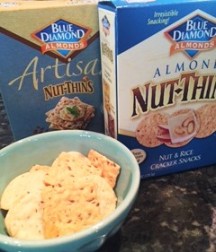 “While all the bulk almonds sold at Natural Grocers are guaranteed to be steam pasteurized, there are some packaged products on our shelves that contain PPO-pasteurized almonds. One such product is Nut Thins, made by BDG. (The almonds used for BDG’s almond milk, Almond Breeze, are pasteurized via blanching and therefore do NOT contain PPO. This is also true of Bob’s Red Mill’s almond meal.) While this is regrettable, we cannot dictate what all our food manufacturers do.”(11)
“While all the bulk almonds sold at Natural Grocers are guaranteed to be steam pasteurized, there are some packaged products on our shelves that contain PPO-pasteurized almonds. One such product is Nut Thins, made by BDG. (The almonds used for BDG’s almond milk, Almond Breeze, are pasteurized via blanching and therefore do NOT contain PPO. This is also true of Bob’s Red Mill’s almond meal.) While this is regrettable, we cannot dictate what all our food manufacturers do.”(11)

Although manufacturers insist the PPO levels are minimal (PPO-pasteurized almonds contain about 1/2500 of the lowest amount considered potentially dangerous (11), it’s knowing that PPO could have been used on almonds found in items like crackers is unsettling; especially because we, the consumer, are left completely in the dark and ‘non-the-wiser’.
Farmers in a fight!
In 2010, the small farmers fought back against the USDA’s pasteurization rule, finally receiving acknowledgment by the Federal Court that they had the right to challenge the rule that was costing them their livelihood.
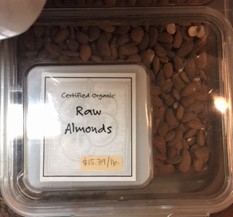 “The Cornucopia Institute, an organization known for its research and defense of family farmers involved in organics, artisan and local food production, was impressed with how many consumers have a real passion for maintaining the availability of raw food and nuts, including almonds, and have been willing to financially support the farmers in their legal challenge.”(12)
“The Cornucopia Institute, an organization known for its research and defense of family farmers involved in organics, artisan and local food production, was impressed with how many consumers have a real passion for maintaining the availability of raw food and nuts, including almonds, and have been willing to financially support the farmers in their legal challenge.”(12)
Raw argument – what’s that about?
Is an almond that has been pasteurized raw? “The FDA believes that since the “essential characteristics” of almonds are unchanged by pasteurization (whether by steam or PPO), it is acceptable to label pasteurized almonds as raw. The raw-food community disagrees, maintaining that exposing any food to a temperature above 118°F automatically disqualifies the food as raw.”(13)
Natural Grocers maintains their own definition of ‘raw’:
“…we base our definition of raw on another criterion—whether the nut can be sprouted. In our opinion, sprouting is a sign of vitality and life. And since steam-pasteurized almonds can be sprouted, we consider it appropriate to label them as raw.”(14)
If almonds are not ‘washed’ via steam, mold, yeast, insect larvae, and bacteria can be present. According to Wendy Larson—general manager of Big Tree Organics, a processing plant for a coop of organic almond growers in California— “There really does need to be a washing step.” For Big Tree that means steam pasteurization. Larson feels strongly that the inside of the nut is not compromised, and is backed by the Almond Board of California, “…preliminary studies funded by the ABC have reportedly shown no significant degradation of the almonds’ essential nutrients.”(14)
On to Acrylamide.
According to the FDA, “Acrylamide is a chemical that can form in some foods during high-temperature cooking processes, such as frying, roasting, and baking. Acrylamide in food forms from sugars and an amino acid that are naturally present in food; it does not come from food packaging or the environment.”(15)

The danger appears when foods reach over 250 degrees for long periods of time; since potatoes produce high levels of acrylamide, potato chips and French fries sit at the top of the list. It’s really when you see a deeper brown than a light brown coloring from the above methods that increases the acrylamide content.
Boiling and steaming do not typically form acrylamide. *Check website below to learn how to limit acrylamide in your diet.
What does Acrylamide have to do with roasted nuts?
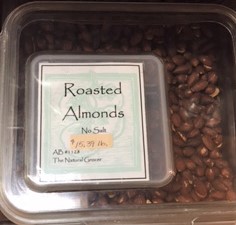 Acrylamide can indeed form when nuts are roasted, although the amount varies not only by degree of roasting but also by the type of nut. One 2005 study, for example, found higher levels in dark roasted almonds from the US…”(16)
Acrylamide can indeed form when nuts are roasted, although the amount varies not only by degree of roasting but also by the type of nut. One 2005 study, for example, found higher levels in dark roasted almonds from the US…”(16)
“Testing by the US Food and Drug Administration has found wide variations in acrylamide content not only by food type but by brand. Levels in cashews and peanuts were very low or undetectable. Acrylamide amounts in almonds were higher but generally lower than in potato chips.”(16)
According to livingnutz.com, almonds have high amounts of asparagine, which can create potential health threats when roasted. Their recommendation, eat them raw.
USDA researching new pasteurization methods.
Although we have determined that roasting nuts may deprive us of nutrients, and subject us to acrylamide, at least the USDA is researching new heat techniques to deal with the PPO problem. They have been testing methods of using hot air roasting and infrared heat to more efficiently rid nuts, like almonds, of bacteria.
Based on my research, I’ll stick with raw organic nuts. But if you’re interested in the research, check out the link below:
Best nut for your buck!
 Organic nuts are pricey, but obviously worth the money for peace of mind and a healthy body. Whether you buy them at the grocery store or a quaint corner market, eating a variety of nuts, which are high in fat but low in saturated fat, in moderation, is really good for you.
Organic nuts are pricey, but obviously worth the money for peace of mind and a healthy body. Whether you buy them at the grocery store or a quaint corner market, eating a variety of nuts, which are high in fat but low in saturated fat, in moderation, is really good for you.
Since all nuts are not created equal, we get a variety of nutrients and antioxidants from eating different types of nuts and seeds. According to health.com, a 2004 review in the Harvard Medical School Family Health Guide concluded that a mixture of nuts fits the bill, especially if they are raw and unsalted.

Keep your nuts cool!
 The best way to store nuts is to refrigerate or freeze them; why would you risk your nuts going rancid after taking all that time to be educated on ‘to roast or to raw’. You can get a year out of nuts in the fridge, and up to 2 years in the freezer. If you leave them out at room temperature, you may only get a few months, and make sure there’s no humidity in the house. *Check website below for table on storing nuts.
The best way to store nuts is to refrigerate or freeze them; why would you risk your nuts going rancid after taking all that time to be educated on ‘to roast or to raw’. You can get a year out of nuts in the fridge, and up to 2 years in the freezer. If you leave them out at room temperature, you may only get a few months, and make sure there’s no humidity in the house. *Check website below for table on storing nuts.

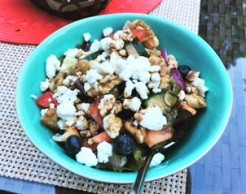 Personally, I love my nuts cold; they’re crunchier! I love nuts as a snack, and without a doubt on salads and cereal. My bigger problem is not eating too many! Being educated about our food seems necessary in today’s world. Whether you choose raw over roasted, organic over natural; whether chemicals scare you or you brush them off, as always, it’s your decision to make, which is a wonderful privilege! So follow your conscience, listen to your body, and choose the best nut for you; and above all, enjoy!
Personally, I love my nuts cold; they’re crunchier! I love nuts as a snack, and without a doubt on salads and cereal. My bigger problem is not eating too many! Being educated about our food seems necessary in today’s world. Whether you choose raw over roasted, organic over natural; whether chemicals scare you or you brush them off, as always, it’s your decision to make, which is a wonderful privilege! So follow your conscience, listen to your body, and choose the best nut for you; and above all, enjoy!
*Limit Acrylamide in diet: http://www.fda.gov/ForConsumers/ConsumerUpdates/ucm374855.htm
*Nut Storage: http://ucfoodsafety.ucdavis.edu/files/44384.pdf
References:
(1) http://www.livestrong.com/article/324603-nuts-roasted-vs-raw/
(2) http://www.livestrong.com/article/446108-is-nutrition-lost-when-nuts-are-roasted/
(3) http://www.prevention.com/content/which-healthier-raw-nuts-vs-roasted-nuts
(5) http://www.pccnaturalmarkets.com/sc/1110/natural.html
(6) http://www.justalmonds.com/category_s/55.htm
(7) https://pubchem.ncbi.nlm.nih.gov/compound/Propylene_oxide#section=Top
http://www.pccnaturalmarkets.com/sc/1110/natural.html
(9) http://www.justalmonds.com/category_s/55.htm
(15) http://www.fda.gov/Food/FoodborneIllnessContaminants/ ChemicalContaminants/ucm053569.htm
Thank you for the information. Came across your article while doing my own research. The things you learn when you challenge what you take for granted
LikeLike